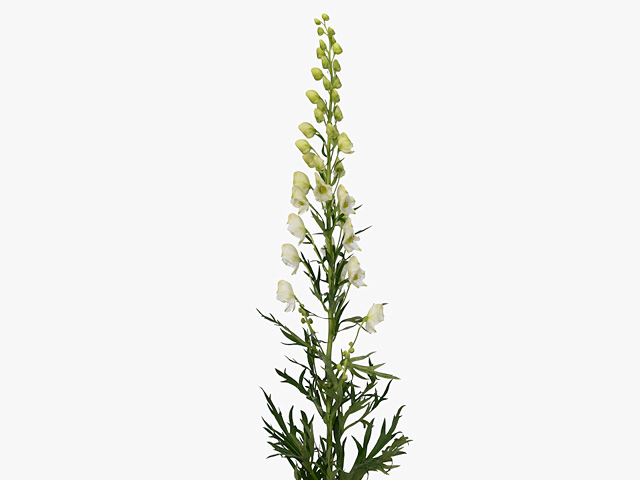Aconitum napellus 'Album'

| Flower type | Single |
| Flower scent | Unscented |
| Winter hardness | Excellent (USDA-zone 1,2,3,4) |
| Flower color | White-white-155A |
| Leaf, scent | Unscented |
| Flower diameter | 2,5 - 3 cm |
| Plant height | 1 - 1,2 m |
| Inflorescence | Raceme |
| Flowering month(s) | June; July; August |
| Light conditions | Semi-shades; Sunny |
| Leaf division | Tricompound; Diversely compound |
| Leaf, main color | Dark green |
| Leaf colour, pattern | Unicolored |
| Flower color distribution | Unicolored |
| Toxicity (if consumed) | Highly toxic |
| Moisture requirements | Moist |
| Soil type | Humus rich |
Monkshood, scientifically known as Aconitum napellus 'Album', is a captivating flower that adds elegance and beauty to any garden. It belongs to the buttercup family (Ranunculaceae) and is a popular choice among gardeners for its stunning white blooms and excellent winter hardiness.
The single flowers of Aconitum napellus 'Album' are breathtakingly beautiful, with a pure white color that can be described as white-white-155A according to the Royal Horticultural Society's color chart. These flowers have a diameter of about 2.5 to 3 cm and are arranged in racemes, creating a visually striking display when in full bloom.
One of the unique features of Aconitum napellus 'Album' is its unscented flowers. While many flowers rely on their fragrance to attract pollinators, Monkshood showcases its beauty through its visual appeal alone. This makes it an excellent choice for those who prefer flowers without any overpowering scent.
With its excellent winter hardiness, Aconitum napellus 'Album' thrives in USDA hardiness zones 1, 2, 3, and 4. This means that even in colder regions, this plant can withstand freezing temperatures and continue to flourish. It exhibits resilience and is a reliable addition to any garden, providing year-after-year beauty.
In terms of its foliage, Monkshood has dark green leaves that are tricompound or diversely compound, adding to the plant's overall aesthetic appeal. The leaves are unscented and have a unicolored pattern, fitting seamlessly with the white blooms.
However, it is important to note that Aconitum napellus 'Album' is highly toxic if consumed. The plant contains toxic alkaloids that can be harmful if ingested, and extreme caution should be exercised when handling it. This makes it vital to keep this plant out of reach of children and pets to ensure their safety.
Monkshood thrives in semi-shaded to sunny light conditions, making it versatile in terms of its placement in the garden. It prefers moist soil, rich in humus, and benefits from regular watering to maintain optimal growth and blooming.
As a midsummer bloomer, Aconitum napellus 'Album' graces the garden with its presence from June to August. These months are characterized by the magnificent display of the pure white flowers, creating a serene and tranquil atmosphere.
In conclusion, Aconitum napellus 'Album', or Monkshood, is a striking garden plant that offers elegance and beauty to any landscape. Its white-white-155A flowers, unscented blooms, and excellent winter hardiness make it a popular choice among gardeners. However, its toxicity should be noted, and caution should be exercised when handling this plant. With its adaptability to various light conditions and preference for humus-rich, moist soil, Monkshood is a delightful addition to any garden, providing captivating beauty throughout the summer months.
Market availability index by month:
| Jan. | Feb. | Mar. | Apr. | May | Jun. | Jul. | Aug. | Sep. | Oct. | Nov. | Dec. |
|---|---|---|---|---|---|---|---|---|---|---|---|
| 2 | - | - | 3 | 4 | - | - | - | - | - | - | - |